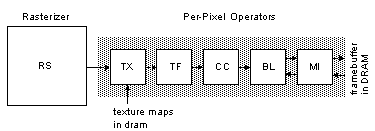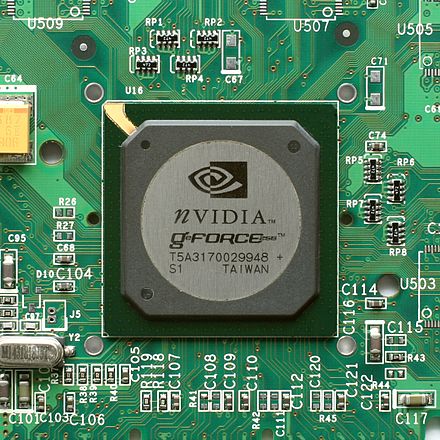021. 现代显卡之二
T&L
上一节曾说过,GPU的主要作用是把3D场景变成一个2D图像。在没有GPU的时候,这部分工作要么由照像机来做,要么由人眼来做。这里涉及的主机是几何学。 主要需要解决的问题为Transform, clipping and lignting, 简称T&L或TCL。
- Transform
即将一个3D物体变化为2D图像,基本做法是投影,包括透视投影和垂直投影。 其实这里面还会涉及把物体的"物体坐标"转换成世界坐标,再转换成"相机坐标"等。这涉及一系列矩阵变换。
- clipping
3D物体投影到2D平面上后,或是投影过程中,发现有一些部分是不应该被看见的,这时需要根据遮挡信息等把他们裁掉。
- lighting
光把3D物理投影到2D平面并不能给人们带来足够的真时感,甚至会投影成混乱一团像素,让人看不懂倒底是什么东西。因为投影的过程中缺少光照信息。同样的几何体,由于光照角度不同,材质不同,可能会显示出非常不一样的颜色,人眼需要这种颜色或灰度变化来区分物体间的位置关系。
在显卡被发明之前,一些做游戏的公司就已经发现了这套理论,1993年arcade公司就实现了能做T&L的硬件,1997年任天堂的游戏机上也有了专门的T&L硬件。PC上由于人们认为PC的CPU性能足够强大,所以很长一段时间内,大家都用软件去实现T&L。直到1999年,nvidia的GeForce 256才引入硬件T&L支持。
本小节我们就来看看这段历史。
RCP
RCP,即Reality Coprocessor, 是由Silicon Graphics公司为任天堂研发的。它包含两部分,RSP和RDP,即Reality Signal Processor和Reality Display Processor。
RSP
RSP的主要做是几何运算,对应的是T&L中的T和L。 RDP的主要作用是栅格化和纹理贴图。

RSP是一颗MIPS CPU,它的固件实现了一个程序,这个程序可以读取一个指令序列,解析指令序列中的指令并执行相应的指令。这些指令称为微码,micro code。程序员将一系列微码组成一个列表,称为display list或是command list。RSP则按照display list去执行。

RSP的微码看起来像是C函数调用,但实际上它们可能是一些打包二进制比特流的宏。熟悉opengl的同学可能会觉得它们和opengl的API有点像。
其操作思路与opengl也是很相似的,先要指定一些顶点,一些变换矩阵,一些纹理,对应的api如下:
gsSPMatrix(Mtx *m, unsigned int p)
gsSPVertex(Vtx *v, unsigned int n, unsigned int v0)
gsSPTexture(int s, int t, int levels, int tile, int on)
gsSPClipRatio(FRUSTRATIO_3),
Lights3 light_structure1 = gdSPDefLights3(
ambient_red, ambient_green, ambient_blue,
light1red, light1green, light1blue,
light1x, light1y, light1z,
light2red, light2green, light2blue,
light2x, light2y, light2z,
light3red, light3green, light3blue,
light3x, light3y, light3z);
gsSPSetGeometryMode(G_LIGHTING),
gsSPSetLights3(material1_light),
gsSPVertex( /* define vertices for object 1 */ );
/* render object 1 here */
gsSPLight(&material2_light.l[0], LIGHT_1),
gsSPLight(&material2_light.a, LIGHT_2),
gsSPVertex( /* define vertices for object 2 */ );
/* render object 2 here */
guLookAtHilite(&throw_away_matrix, &lookat, &hilite,
Eyex, Eyey, Eyez,
Objectx, Objecty, Objectz,
Upx, Upy, Upz,
light1x, light1y, light1z,
light2x, light2y, light2z,
tex_width, tex_height);
gsDPLoadTextureBlock_4b(hilight_texture, G_IM_FMT_I,
tex_width, tex_height, 0,
G_TX_WRAP | G_TX_NOMIRROR,
G_TX_WRAP | G_TX_NOMIRROR,
tex_width_power2,
tex_height_power2,
G_TX_NOLOD, G_TX_NOLOD),
具体的含义见: http://level42.ca/projects/ultra64/Documentation/man/pro-man/pro11/index11.6.html
RCP的输入是一些顶点、纹理坐标、光照条件等,输出是多边形。 这些多边形进入RDP进行进一步处理。
RDP
Reality Display Processor。 它的作用是把多边形进行栅格化,输入为high-quality, Silicon Graphics style pixels that are textured, antialiased, and z-buffered.
听起来的大致意思是这是一些像素,每个像素都已经映射了纹理,做了抗锯齿,并且包含z缓冲即深度信息。与opengl里面的fragment,片元几乎是一回事儿。
RDP会按照固定的步骤处理这些片元。在某种模式下的步骤如下:

在这种模式下,它一个周期只能处理1个像素,在另一些模式下,它可以实现一个周期处理两个像素。
RCP已经很像是一款固定流水线的GPU了,美中不足的是它的RSP部分是用MIPS处理器来做的,速度就慢了不少。
| Block | Functionality |
|---|---|
| RS | Generates pixel and its attribute covered by the interior of the primitive. |
| TX | Generates 4 texels nearest to this pixel in a texture map. |
| TF | Bilinear filters 4 texels into 1 texel,or performs step 1 of YUV-to-RGB conversion. |
| CC | Combines various colors into a single color,or performs step 2 of YUV-to-RGB conversion. |
| BL | Blends the pixel with framebuffer memory pixel, or fogs the pixel for writing to framebuffer. |
| MI | Fetches and writes pixels from and to the framebuffer memory. |
GeForce 256

这个GPU支持Direct3D 7。称为世界上的第一个GPU。
Nvidia如些骄傲于这个芯片,已至于官网上还有它的链接: https://www.nvidia.com/page/geforce256.html
这时GPU的定义为:a single-chip processor with integrated transform, lighting, triangle setup/clipping, and rendering engines that is capable of processing a minimum of 10 million polygons per second.
一秒钟可以得处理1000万个多边形。
256的意思是"256位,4流水线渲染引擎"。相当于4核的GPU,一个周期可以处理4个像素。
与RCP不同的是,所有的处理都是硬逻辑完成的,而不是RCP那像由运行于CPU上的固件完成。
Nvidia不愧为世界上第一个GPU,它有现代GPU的所有特点:
- 硬件T&L
- 多核
- 支持一款3D API。
可以说硬件支持T&L是GPU和非GPU的分界点,Direct3D 7,是固定流水线GPU和非固定流水线分界点。当Direct3D 8出来的时候,vertex shader, fragment shader就已经有了,这时就是非固定流水线的GPU了。
太晚了,今天就写到这里。
发现一个好文章还没读完,供大家参考: https://www.techspot.com/article/653-history-of-the-gpu-part-2/